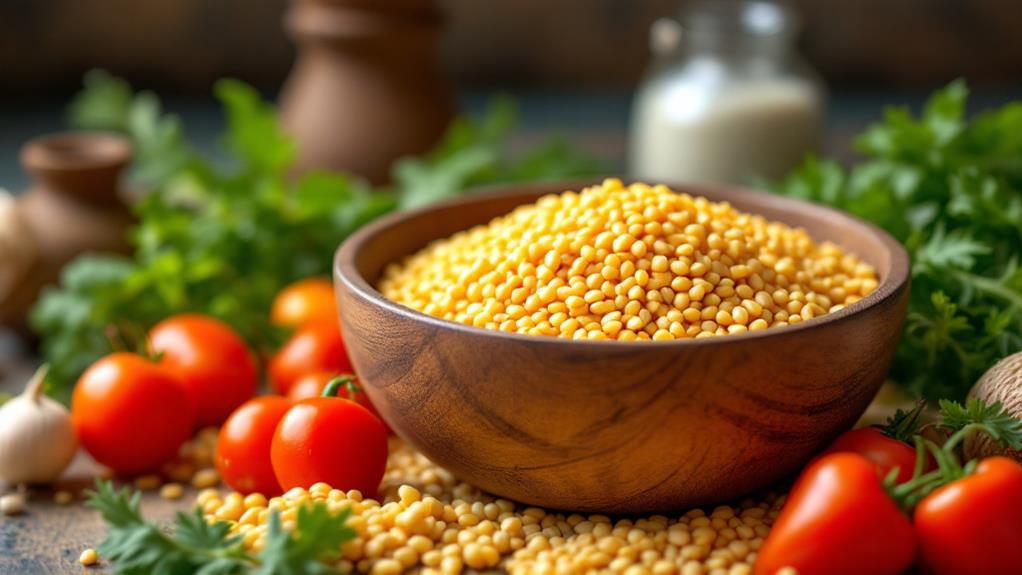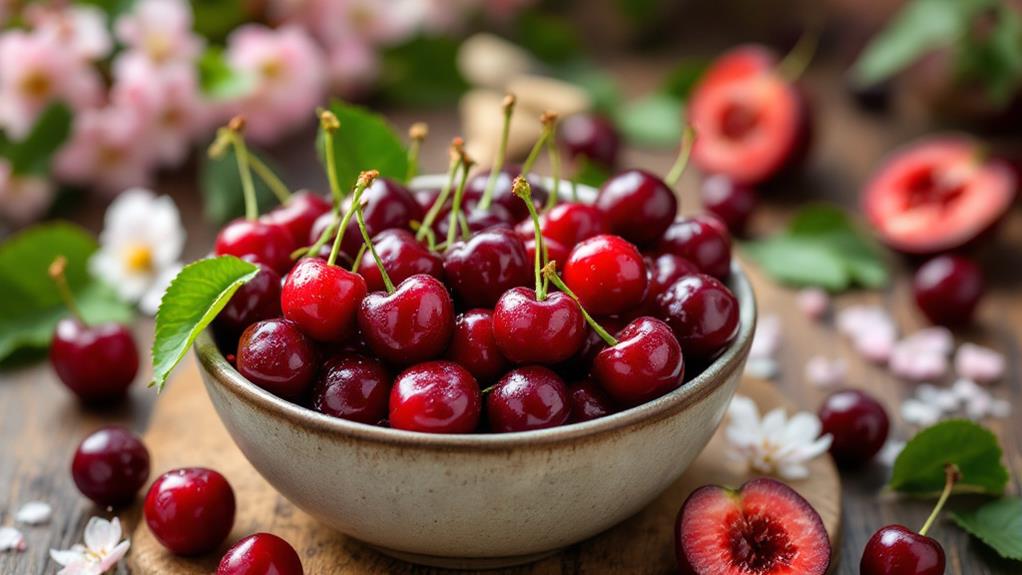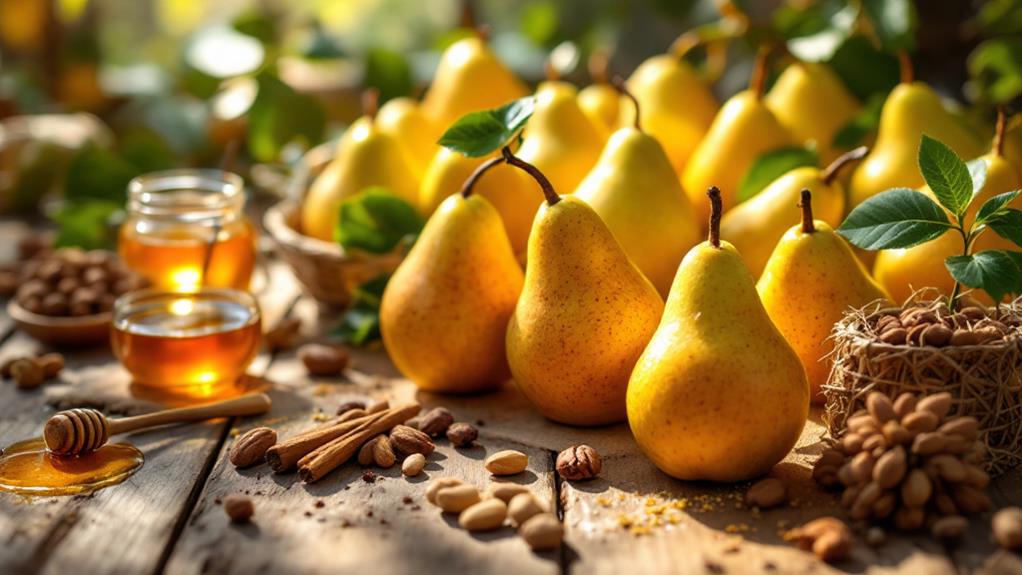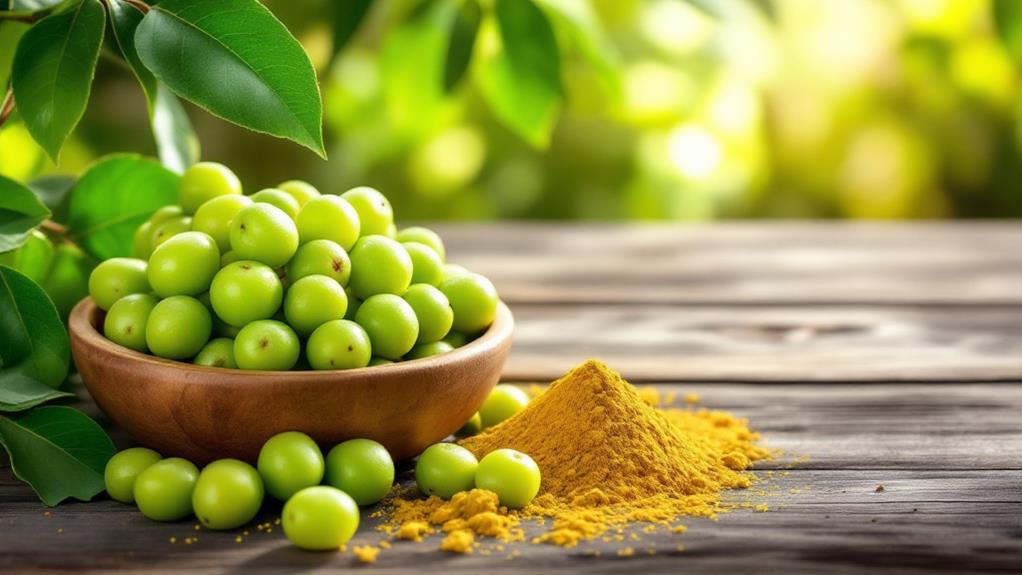The Uses and Health Benefits of Vegetable Fern: A Nutritional Powerhouse
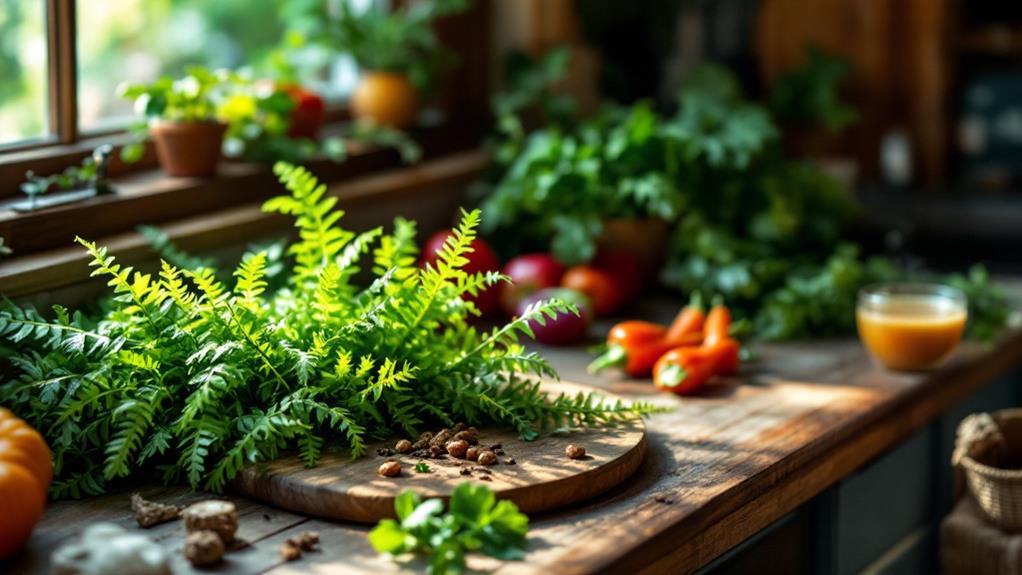
You'll find that vegetable fern is a nutritional powerhouse rich in protein, carbohydrates, antioxidants, and flavonoids. It's great for weight management due to being low in calories. This fern aids postpartum recovery and acts as a remedy for coughs, skin infections, and more. Traditionally, it's crucial in folk medicine and cultural cuisine, offering health benefits while cooling the body. To enjoy its culinary uses, try it stir-fried with garlic or mix it in salads with lemon and Thai chili. Confirm proper cooking and storage to enhance benefits. Interested in expanding your knowledge about this versatile ingredient?
Nutritional Profile
When you dig into the nutritional profile of vegetable fern, you'll find it's a powerhouse of important nutrients. This green marvel is packed with protein, carbohydrates, and antioxidants, making it an excellent enhancement to your diet. The rhizome of the vegetable fern is particularly remarkable, containing 18 active ingredients like Tetradecanoic Acid and N-hexadecanoic acid, which contribute considerably to its health benefits.
The leaves aren't to be overlooked either. They're loaded with flavonoids, carbohydrates, glycosides, and steroids, all known for their potent antioxidant properties. These compounds play a fundamental role in protecting your body from oxidative stress and supporting general wellness.
What's more, vegetable fern is low in calories, making it a fantastic option for maintaining or losing weight without sacrificing indispensable nutrients. It's a nutritional powerhouse that offers a wide array of vitamins and minerals, promoting general health and well-being.
Health Benefits
Undeniably, the vegetable fern offers a multitude of health benefits that make it a valuable improvement to your diet. This remarkable plant is not only low in calories but also rich in vital vitamins and minerals, making it perfect for health-conscious individuals. Its cool properties have been recognized in traditional medicine, where it has been used to aid postpartum recovery in women, showcasing its restorative capabilities.
Moreover, the vegetable fern is effective in treating numerous ailments. If you're battling a cough, skin infection, diarrhea, dysentery, or fever, this plant can be your go-to natural remedy. Its traditional use in India as a remedy for colds and coughs highlights its role in natural healing practices. The leaves of the vegetable fern are packed with flavonoids and antioxidants, which are critical in combating oxidative stress. By including this plant in your diet, you're supporting your general health.
Additionally, maintaining healthy blood is another significant benefit of the vegetable fern. The antioxidants present in the plant help protect your blood cells from damage, ensuring they function effectively. Incorporate the vegetable fern into your meals, and you'll be taking a proactive step towards a healthier lifestyle.
Traditional Uses

Having examined the health benefits of the vegetable fern, let's now focus on its traditional uses. You might be surprised to learn how deeply ingrained this plant is in numerous traditional medicine practices. Known for its cooling properties, the vegetable fern is a go-to remedy for a wide range of ailments. In many cultures, it's considered crucial in postpartum recovery, helping new mothers regain their strength and health after childbirth. This use underscores its role as a healing agent in traditional medicine.
If you've ever suffered from a persistent cough, you might find it intriguing that the vegetable fern has been a staple in folk medicine for treating coughs, including severe ones like hemoptysis. In India, it's widely used as a natural remedy for colds and coughs, emphasizing its significance in traditional health practices. This plant isn't just about medicinal benefits, though. It's also a significant part of Hmong cuisine, illustrating its cultural and nutritional value beyond just health remedies. So, when you think of vegetable fern, remember its dual role in serving both as a healing herb and a culinary delight in traditional settings.
Popular Dishes
In the domain of Hmong cuisine, the vegetable fern's versatility shines through its starring role in popular dishes. You can savor its crispness and aroma when it's stir-fried with beef, a classic combination that highlights both taste and nutritional value. The pairing of tender beef with crunchy vegetable fern creates a delightful balance that's sure to please your palate.
If you're looking for a standout side dish, consider stir-frying vegetable fern with garlic. This simple yet flavorful preparation amplifies the fern's natural taste and adds a visually appealing touch to any meal. The garlic not only elevates the flavor but also complements the fern's crunchy texture, making it a perfect accompaniment to your main course.
For a revitalizing twist, try a vegetable fern salad. Boil the fern and mix it with peanuts, lemon juice, and Thai chili. This vegan option is not only invigorating but also brings out the fern's versatility in a lively way. The salad's combination of textures and flavors provides a healthy, satisfying dish that aligns with a commitment to nutritional balance using fresh, locally-sourced ingredients. With these dishes, vegetable fern truly earns its place in your culinary repertoire.
Cultural Significance

Vegetable fern is more than just an ingredient in Hmong cuisine; it's a cherished symbol of tradition and cultural heritage. When you incorporate ferns into your meals, you're not just preparing a dish; you're embracing a practice deeply rooted in Hmong history. This leafy green represents a connection to nature and the land, highlighting the importance of using wild vegetables. By including these ferns in your family meals, you're promoting nutritional balance and freshness, essential elements of Hmong food culture.
Through the use of vegetable ferns, you help preserve traditional recipes and cooking methods passed down through generations. This act of culinary preservation isn't merely about taste; it's about maintaining a connection to your ancestors and their ways of life. Furthermore, the appreciation for ferns in Hmong culture underscores the significance of local, seasonal ingredients in promoting health and well-being. By embracing these ingredients, you contribute to a diet that may lower the risk of heart disease, reinforcing the community's commitment to health.
In choosing vegetable ferns, you honor the Hmong's dedication to tradition and underline the role of food in cultural identity and health.
Cooking Techniques
In relation to cooking techniques, incorporating vegetable fern into your meals can be both simple and rewarding. One of the easiest ways to enjoy this nutritional powerhouse is by stir-frying it with garlic. This quick method improves the fern's natural flavors while preserving its abundant flavonoids and antioxidants. If you prefer a softer texture, try boiling the fern for about 5-10 minutes. It becomes a wonderful supplement to salads or as a topping on different dishes, all while keeping its low-calorie appeal.
For a unique twist, add vegetable fern to your soups. It contributes a delightful crunch and elevates the soup's nutrient profile with its rich protein and mineral content. If you're in the mood for a revitalizing salad, combine boiled vegetable fern with peanuts, lemon juice, and Thai chili. This vegan option not only highlights the fern's cool properties but also supports digestive health.
Steaming is another excellent cooking technique for vegetable fern, helping to retain its nutrients. Lightly steamed ferns can be incorporated into stir-fries and rice dishes or simply enjoyed on their own. With these techniques, you're sure to make the most of this adaptable ingredient.
Safety Precautions
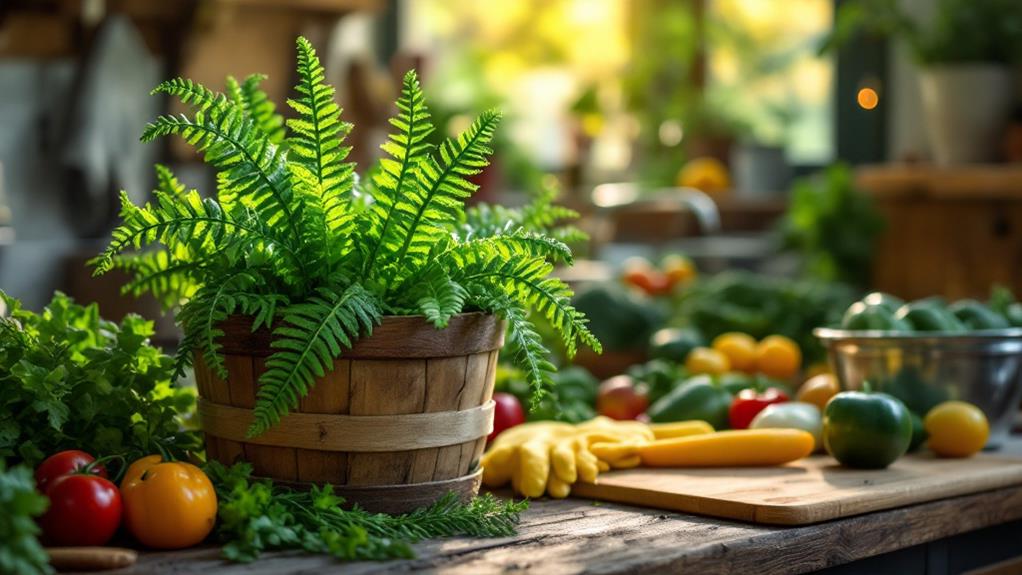
While incorporating vegetable fern into your meals can be a delightful culinary experience, it's essential to keep safety at the forefront. To guarantee that your vegetable ferns are safe to eat, always start by rinsing them thoroughly under cold water. This simple step helps eliminate dirt and contaminants, making them cleaner for your consumption.
Cooking vegetable ferns properly is another significant safety precaution. Eating them raw might increase your risk of foodborne illnesses, so make certain they are well-cooked before serving. You should also be mindful of how you store them. Keep the ferns in a cool, dry place and try to use them within a few days of purchase to maintain their freshness and safety.
Before cooking, inspect the vegetable ferns and remove any brown or wilted ends. Doing so not only improves the quality of your dish but also reduces the risk of spoilage. Finally, be aware of any potential allergies or sensitivities to vegetable ferns. If you're unsure about consuming them, consulting with a healthcare professional can provide peace of mind and confirm that they are safe for you to eat. These steps will help you enjoy vegetable ferns safely and deliciously.
Gardening Tips
Cultivating vegetable ferns in your garden can be a rewarding endeavor that enhances both the beauty and functionality of your outdoor space. To start, choose a location with moist, well-drained soil and partial shade. Vegetable ferns thrive in these conditions, especially when situated near water sources or under the canopy of taller plants.
When it comes to watering, consistency is key. Keep the soil consistently moist but avoid waterlogging. This is particularly significant during dry spells, so regular watering is imperative. Enhance your ferns' growth with a balanced organic fertilizer every few months to provide fundamental nutrients.
Pruning is another critical aspect of caring for vegetable ferns. Regularly prune dead or damaged fronds to promote new growth and improve air circulation. This simple step helps prevent disease and keeps your ferns healthy.
Don't forget to keep an eye out for pests like aphids and slugs. Regular inspections can catch these nuisances early. If needed, utilize organic pest control methods to protect your plants without harmful chemicals.
Sustainable Harvesting

Regarding sustainable harvesting of vegetable ferns, mindful practices guarantee these plants continue to thrive and reproduce. When you harvest these ferns, it's essential to collect only a portion of the fronds, which allows the plant to keep growing strong. Focus on taking the young, coiled ferns while leaving the older fronds intact. This selective approach supports not only the plant's health but also the surrounding ecosystem.
To promote sustainable harvesting, make certain you gather ferns only during the peak season, typically from late April to early June. By limiting your collection to this period, you help prevent overharvesting and encourage the ferns' natural regeneration. Remember, it's not just about when you harvest but also how. Use cutting techniques rather than pulling to minimize root damage and promote future growth.
Before you head out to harvest, don't forget to obtain permission from landowners. Respecting private property and local regulations is vital to your practice. With these rights reserved, you're contributing positively to the environment. By employing these responsible techniques, you guarantee that vegetable ferns remain a thriving and sustainable resource for future generations.
Comparing With Other Greens
You might be familiar with leafy greens like spinach and kale, but vegetable fern stands out with its unique nutritional profile. It's low in calories, making it a fantastic choice for weight management, just like its green counterparts. However, while spinach and kale can be higher in oxalates, vegetable fern offers a different composition. You'll get a surprising 6 grams of protein per cup, which is a significant enhancement for those following vegetarian and vegan diets.
When it comes to vitamins and minerals, vegetable fern takes the lead with higher levels of iron and vitamin C compared to traditional greens like lettuce and collard greens. This means it doesn't just help with weight management but also strengthens your immune system and general health. Its antioxidant properties, including flavonoids, are on par with other greens, helping in disease prevention and maintaining good health.
What truly sets vegetable fern apart is its cool properties in traditional medicine, offering benefits that other greens might lack. Regardless of your aim to diversify your diet or harness specific health benefits, vegetable fern provides a robust alternative to the usual leafy greens. It's time to investigate this nutritional powerhouse!

